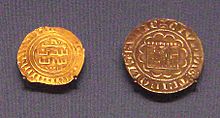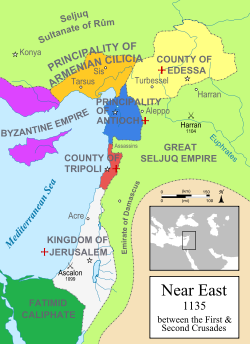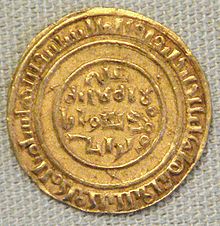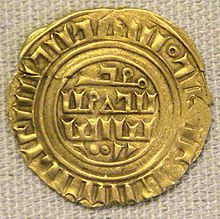- County of Tripoli
-
This article is about the last Crusader state. For other uses, see Tripoli (disambiguation).
County of Tripoli
Comitatus TripolitanusVassal of, in turn, Kingdom of Jerusalem, Principality of Antioch and the Mongol Empire ← 
1102–1289  →
→The County of Tripoli in the context of the other states of the Near East in 1135 AD. Capital Tripoli Language(s) Latin, Old Occitan, Italian (also Arabic and Greek) Religion Roman Catholicism, Greek Orthodoxy, Syrian Orthodoxy, Islam, Judaism Government Monarchy Count - 1102–1105 Raymond IV - 1287–1289 Lucia Historical era High Middle Ages - Established 1102 - Conquered by Qalawun 27 April 1289 The County of Tripoli (1109–1289) was the last Crusader state founded in the Levant, located in what today are parts of western Syria and northern Lebanon, where exists the modern city of Tripoli. The Crusader state was captured and created by Christian forces in 1109, originally held by Bertrand of Toulouse as a vassal of Baldwin I of Jerusalem. The County of Tripoli later became a substate of the Principality of Antioch in the 13th century. In the mid-13th century, its leader Bohemond VI, under the influence of his father-in-law Hetoum I of Cilician Armenia, swore vassalage to the Mongol Empire, and contributed troops to the Mongol conquests in the region. In retaliation, the Sultan Qalawun, of the Muslim Mamluks in Cairo, attacked and destroyed both Tripoli and Antioch, absorbing the territories back into the Islamic Empire in the late 13th century. The Fall of Tripoli took place in 1289.
Contents
Capture by Christian forces
See also: Siege of TripoliThe existence of the County of Tripoli was due primarily to the determination of Raymond IV of Toulouse.[1] Although one of the richest and most powerful of the crusading Princes, Raymond of Toulouse had failed to acquire any Eastern possessions in the aftermath of the First Crusade.[1] Western Lords had been installed in Edessa, Jerusalem and Antioch[2] and Raymond had little success in earning land from the Byzantines. Desperate for a possession in the Holy Land, he decided to take Tripoli by force. In 1103, he began preparing for an attack on the rich port, accompanied by veterans of the 1101 campaign.[1]
The Count of Toulouse began constructing a large castle set on a ridge he named "Mount Pilgrim",[2] a few miles from Tripoli itself. The fort is still known locally as Qal'at Sanjil, or "Saint Giles' castle" in reference to Raymond. The castle remained in Christian hands between 1103 and 1289, longer than any other in the Kingdom of Jerusalem.[1] Even with an intimidating fortress and seasoned troops, the siege wore on, outlasting even Raymond who died on 25 February 1105. However, the various components of the siege remained united, such was the lure of the port. It was a strategic link between the French in the south, and the Normans in the north.[2]
Raymond's cousin and companion on crusade, Count William of Cerdagne, assumed control of the operation, although matters were soon complicated. Raymond's son Bertrand, considered illegitimate by the church, left Toulouse after acting as regent for a decade and arrived in the Holy Land with a substantial army and a large Genoese fleet.[1] A succession contest quickly began and Christian in-fighting threatened the success of the entire siege. King Baldwin called a council with Bertrand, his favourite, and William, who was supported by Tancred, Prince of Galilee. A partition treaty was accepted, whereby William would hold northern Tripoli and pay homage to Prince Tancred, and Bertrand would do the same in the south as a vassal of King Baldwin.[2] With the animosity settled, the King assembled the Christian army for a final attack. Unable to stand against the combined forces of the Kingdom of Jerusalem, Tripoli surrendered on 12 July 1109.[1]
The final Crusader state had entered existence and with it, the Kingdom of Jerusalem controlled the entire east coast of the Mediterranean. The partition treaty agreed at the earlier council soon became immaterial, as William died of an arrow wound, amid allegations of murder. Bertrand therefore became Count of all Tripoli,[2] making reality the dream of his father nearly a decade earlier.
Structure and devolution of power
The Count's holdings and vassals
 County of Tripoli gold bezant in Arabic (1270–1300), and Tripoli silver gros (1275–1287). British Museum.
County of Tripoli gold bezant in Arabic (1270–1300), and Tripoli silver gros (1275–1287). British Museum.
The Count presided over the entire coastline from Maraclea in the north and the Beirut in the south. At the height of Tripoli's power, the Count's authority reached inland to the Krac des Chevaliers fortress.[1] The County was divided into separate Lordships, most based on coastal ports. For themselves, the Counts reserved the coastal strip around the port of Tripoli and the hostile Montferrand region to the east.[1] A quarter of the county was given to the Genoese, as thanks for their aid in capturing it for Bertrand. He gave the port of Jubail to a Genoese admiral, Guglielmo Embriaco, whose descendants remained vassals of the Count until the late 13th century.[1]
Homage to the King
Baldwin I had been vital in creating the last Crusader state. He had backed Bertrand since he arrived in the Levant and organised the forces that eventually broke the Muslim resistance in the area. However, like the Lordship of Galilee, Tripoli remained outside of direct Royal control. The Counts still owed fealty and homage to the monarchy in Jerusalem, but the King "held no direct tenurial, legal or patronage rights over the Count".[1]
However, in times of crisis, the King would often act as regent or guardian of the County, reflecting the close ties between Jerusalem and Tripoli.
The Military Orders
Tripoli's exposed but vital position made it a target for Muslim forces along the length of its borders. In 1137, the Count's personal holdings in Montferrand were lost.[1] The problem was exacerbated when the Hashshashin established themselves in the Nosairi mountains to the north.[1] To counter their strengthening Muslim neighbours, the Count gave the Knights Hospitaller large stretches of frontier land in 1144. The Hospitallers held much of the Buqai'ah plain and were key to Tripoli's defence.[1] Their fortress at Krac des Chevaliers was the most imposing feature in the County.
During the 1150s, the Knights Templar also acquired land in Tripoli.[1] Their fortifications at Tartus were important in bolstering the Count's defenses.
Religion
As the seat of the Kingdom, Jerusalem's religious figures were supposed to give the lead for the other states. However, the religious hierarchy in Tripoli gave its allegiance to the Patriarch of Antioch. Even after a Papal edict instructing Tripoli to fall under the jurisdiction of the Patriarch of Jerusalem, it did not. This is likely due to the close political alliance formed between Tripoli and Antioch by Count Pons.[1]
War with the Seljuk Empire
Shaizar
As a vassal of the Kings of Jerusalem, the new Count Bertrand was drawn into the Christian war with the Seljuk Turks. In 1111, Mawdud bin Altuntash lead an invasion force of Muslims against the Crusader states of Antioch and Edessa. Bertrand and the King marched to defend the Christians in the north. At the Battle of Shaizar, accompanied by Tancred, Prince of Galilee and the Count of Edessa, they held back the Seljuk forces and kept the Crusader states intact.
Hab
In 1119, the Seljuk Empire again descended on Antioch, scoring several victories, including the crushing of Christian forces at the Battle of Ager Sanguinis. With Antioch's army obliterated, Count Pons of Tripoli and King Baldwin II of Jerusalem rushed north to defend the Christian possessions. The two armies met at the Battle of Hab, with the Count and his knights from Tripoli composing the right flank of the Christian forces. Fighting was heavy and the result seemed to turn in the Turks' favour. Many Christians fled the field, but the Count managed to battle through the Muslim ranks and find the King. Together with their remaining troops, they continued to battle the Turks and eventually forced a full retreat. Antioch was again kept from Muslim control.
Azaz
Count Pons again marched out of Tripoli against the Turks in 1125. Islamic troops had invaded the County of Edessa, besieging the town of Azaz. Count Pons, with the King and the Count of Edessa, lured the besieging forces away from the town and onto dry plains. By the time the Turks realised it was a trap, they were surrounded. After long and bloody fighting, the Islamic army was completely defeated.
Civil war
Bertrand of Toulouse (1149)
When the County was created in 1109, Alfonso-Jordan, Count Raymond's son, Bertrand, became Count. However, in the late 1140s, Alfonso arrived with the Second Crusade,[1] determined to press his claim on the County of Tripoli. When he mysteriously died in Palestine in 1148, his own illegitimate son, Bertrand, became head of the movement to take Tripoli.
He challenged the authority of Count Raymond II, grandson of the original Count Bertrand and prepared to invade. Accompanied by a force of Toulousian troops,[1] he attacked and seized the fortress at Arimah, on the road to Tortosa. Raymond was keen to avoid confronting his relative directly and so sent messengers to Nur al-Din and Unur of Damascus. Just months before these Muslim lords had been Raymond's foes at the Siege of Damascus, but now he invited them to attack his rival. They obliged, taking Arimah and capturing Bertrand, who spend the next decade in Muslim prisons. After its fortifications had been destroyed, Arimah was returned to the Count.[1]
Guy II Embriaco (1277–82)
Between 1275 and 1277, Count Bohemond VII was too young to rule and so Bishop Bartholomew of Tortosa acted as regent.[3] However, he was opposed by Bishop Paul of Tripoli, a personal friend of Templar Grandmaster William of Beaujeu.[3] When Bohemond came of age in 1277 and took control of the County, he had inherited the opposition of Beaujeu's Templars;
This was the beginning of the great war between the Prince and the Temple, from which much evil arose[4]
The Templars sought to unsettle the Count by receiving Guy II Embriaco, Bohemond's former vassal in Jubail.[3] The two had once been friends but were now enemies after personal grievances. The Grandmaster pledged his support to Guy and, fearing a coup, the Count attacked the Templar house in Tripoli and ordered their lands destroyed, including forests at Montroque.[3] The Templars quickly retaliated, torching Botron and laying siege to Nephin. Bohemond and Guy faced each other near Botron, Guy supported by 30 Templar knights,[3] but fighting was indecisive.
Throughout the next year, battles were waged at sea along the length of Tripoli's coastline. Templar galleys disrupted trade at Tripoli and the Count's ships attacked the Templar's castle at Sidon.[3] The final confrontation came in 1282, when Guy and the Templars planned a final assault on Tripoli. They planned to base themselves at the Templar house, but arrived to find the Spanish preceptor, Reddecoeur, was not there. Fearing a set-up, they fled to the Hospitallers, but were forced to surrender. The Count showed no mercy with his captives, having all the Templars immediately executed. Guy's other followers were blinded.[1] Guy himself, along with his brothers and cousins, were detained in the castle moat at Nephin and left to starve to death.[1]
Eastern massacre
In 1152, Count Raymond II was assassinated by the Hashashin. He was the first recorded non-Muslim victim of the sect[1] and his death had serious repercussions:
The immediate reaction to Raymond's murder exposed a latent racism in the Franks, who massacred the eastern indigenous population of Tripoli regardless of their religion[1]
The savage killings in the wake of Raymond's death did nothing to quell tensions between the Christian and Muslim populations in Tripoli.
Fall to the Muslims
See also: Siege of Tripoli (1271)See also: Fall of TripoliInevitably, constant infighting, lack of resources and Muslim military pressure took its toll on the Kingdom. By the 1280s, only two crusader states remained, the remnants of Jerusalem and Tripoli. The Egyptian Sultan Qalawun was determined to destroy the last Christian possessions and turned his attention on Tripoli. Although he had a peace treaty with the County,[1] he attacked it in March 1289.[2] Despite desperate defense operations, the County fell and was merged with Qalawun's empire.[1] The last crusader state to be created, out-lived only by Jerusalem itself, had been destroyed.
Counts of Tripoli
- Raymond IV of Toulouse (1102–1105)
- Alfonso-Jordan (1105–1109)
- William-Jordan, as regent (1105–1109)
- Bertrand of Toulouse (1109–1112)
- Pons of Tripoli (1112–1137)
- Raymond II of Tripoli (1137–1152)
- Raymond III of Tripoli (1152–1187)
- Raymond IV of Tripoli (1187–1189), son of Bohemond III of Antioch.
- Bohemond IV of Antioch-Tripoli (1189–1233, also Prince of Antioch 1201–1216 and 1219–1233)
- Bohemond V of Antioch-Tripoli (1233–1252, also Prince of Antioch)
- Bohemond VI of Antioch-Tripoli (1252–1275, also Prince of Antioch 1252–1268)
- Bohemond VII of Antioch-Tripoli (1275–1287)
- Lucia of Tripoli (1287–1289)
Tripoli is lost to Egyptian forces
- Lucia of Tripoli (1289 – c. 1299)
- Philip of Toucy (c.1299 – 1300)
passes to the Kings of Cyprus and Jerusalem
- Peter I of Cyprus (1345–1359)
- Peter II of Cyprus (1359–1369)
- James of Lusignan (? – c. 1396), cousin
- John of Lusignan (c. 1396 – c. 1430), son
- Peter of Lusignan (c. 1430 – 1451), brother, Regent of Cyprus
- Juan Tafures (1469 – 1473)
Great Officers of Tripoli
- Main article: Officers of the County of Tripoli
Tripoli's administration was controlled by officers in several important posts.
References
- Richard, Jean (1999). The Crusades: c. 1071-c. 1291. Cambridge University Press. ISBN 978-0-521-62566-1.
Crusader States Levant Kingdom of Jerusalem · Principality of Antioch · County of Edessa · County of Tripoli · Kingdom of Cilicia · Kingdom of CyprusLatin Greece Baltic Crusades Portal Categories:- Former monarchies
- Former countries in the Middle East
- States and territories established in 1102
- States and territories disestablished in 1289
- 1289 disestablishments
- County of Tripoli
- Crusader states
Wikimedia Foundation. 2010.




